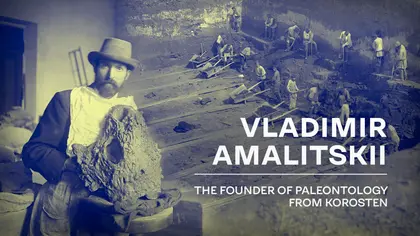VLADIMIR PROKHOROVICH AMALITSKII was a geologist, paleontographer, the “godfather” of the study of vertebrate fauna from the Permian period, and one of the founders of paleontology. He was the one who discovered the species of reptile which without exaggeration can be called the ancestor of all mammals, that is our distant ancestor.
BURIED DINOSAURS WHILE DIGGING UP NORTH
Most of us assume that the first animals on Earth “that really count” were dinosaurs, which were found solely in warm climates. Earlier, even among scientists, the idea reigned that sediments in the far northern regions were devoid of fossils. These ideas were refuted by Vladimir Amalitskii, the first one in the world to find the remains of creatures that “were not supposed to be there” among these rocks that were supposedly empty. He also discovered new creatures that were not even dreamed of earlier in the imaginations of scientists.
AMALITSKII PROVED THAT:
- the supercontinent called Pangea, which united almost all the land of the Earth, did exist (the evidence were the remains of lizards on different continents which were previously thought to have wandered exclusively through the tropics and would have been unable to reach other regions across oceans);
- a quarter of a billion years ago, every part of the earth had a “tropical” climate; - the flora and fauna of northern Eurasia could have been called the “sisters” of the plants and animals of southern Africa (despite the fact that there are nearly 20,000 kilometers between them);
- at least five species of reptiles, earlier unknown to science, had existed long before the era of the dinosaurs;
-The inostrancevia, which grew up to 3.5 meters in length, was the first giant saber-toothed predator on Earth;
- “Dvinia prima” is nothing less than the ancient ancestor of all mammals.
Evidence about the titanic volumes of work performed during his research is provided by the following fact: from the excavation site to Warsaw, the scientist forwarded several tens of tons of precious cargo: thousands of bones and skulls, as well as dozens of skeletons of prehistoric animals, loading up two rail cars.
THE ANCESTOR OF HOMO SAPIENS: A REPTILE THAT WAS COVERED WITH FUR
Among the five “northern” types of creatures of the era before the dinosaurs that have been discovered (the kotlasia, scutosaurus, inostrancevia, dvinosauria, and dvinia), the last one in the list became the sensational “star” of the so-called Permian period (265-252 million years ago). Why is this?
From time to time, information appears on the media about paleontologists having identified another leading candidate for the role of the prehistoric ancestor of homo sapiens. Some Brits recently announced that they had discovered the ancestor: a rat-like creature that lived about 145 million years ago. Japanese specialists presented their candidate, but this was four times younger. An international team of scientists from Germany, Spain and Finland used artificial intelligence to define a “contender” who lived about 80 million years ago.
This would all be well and good if it were not for one thoroughly overlooked fossil. Because Amalitskii’s dvinia is a transitional form between reptiles and mammals, existed almost a quarter of a billion years ago. It did not look remarkable; it was the size of a large cat or small dog and was covered with sparse wool. It was probably warm-blooded, fed both plant and animal food. That is, although it was not yet a mammal, it was already not a reptile. A “more ancient” ancestor of man has not yet been found.
INTERESTING FACTS
- For 300 years, Amalitskii’s maternal ancestors were nobles and political figures of the Polish-Lithuanian Commonwealth and Grand Duchy of Lithuania.
- Amalitskii’s mother’s second cousin, the artist Mykola Prakhov, wrote: “Belarusian and Ukrainian languages and songs were heard for holidays at my grandmother`s Evdokia Vasilievna house.”
- The first depiction of skulls and skeletons from the Amalitskii collection was published by the British zoologist Edwin Lankester in the book “Extinct Animals” in 1936.
- Three years in a row, from 1895-1897, Amalitskii and his wife Anna Petrovna spent summer sleeping in the open air, in a boat.
- Anna Petrovna was 8 years younger than her husband. She studied at the Art School of the Society for Encouragement of the Arts in St. Petersburg, and later joined the foreign literature department for higher studies, but did not finish them because she moved to Warsaw with her husband. She devoted all her skills to her husband’s work: she helped with him with illustration and translation of articles and books.
- Amalitskii’s family was close friends with the artist Ilya Repin.
- During excavation, locally-hired help regularly hid the bones that they found in order to “dissect” them at home, as rumors had spread that their clever boss was actually digging gold.
- Amalitskii’s findings have become the prototypes of terrible predators shown in many films. The most famous of them are: “Walking with monsters. Life Before Dinosaurs ”(BBC documentary, 2005); “Primeval” (a dramatic television program by Impossible Pictures, 2007-2011); “Earth: Making of a Planet” (National Geographic documentary, 2010).
FROM THE DOSSIER OF VLADIMIR AMALITSKII
- Amalitskii was born on July 13, 1860 in the village of Staryky near Korosten (Zhytomyr region).
- He graduated from the Faculty of Physics and Mathematics of St. Petersburg University (1883). He was in charge of the geological collection (1886-1889), Lecturer at St. Petersburg University (1889- 1890), Warsaw University (1890-1904) and Polytechnic Institute (1904-1908). He was then the director of the Warsaw Polytechnic Institute (after 1908) and Rostov University.
- He died on December 28, 1917 in Kislovodsk (now Stavropol Krai of the Russian Federation).
- In Kotlas (a town near Arkhangelsk), in 2005, a monument was erected, which has this inscription: “In 1899, an outstanding geologist and paleontologist Vladimir Amalitskii conducted excavations here.” Later a park was also established with full[1]size sculptures of the beasts that were discovered by this scientist born near Korosten.
«I shoveled in so many stones that the gravel I got would be enough for a large section of a beautiful highway». - Vladimir Amalitskii.
This article by Nadiia Avramchuk and Mykola Sukhomozsky is reprinted with the publisher's permission from the book (UN)Celebrated Ukrainians Who Changed the Course of History, SAMIT-KNYHA, Kyiv, 2020.
![[VIDEOS] North Korean Troops in Russia Confirmed](https://static.kyivpost.com/storage/2024/10/19/a6f6a4c5d74d066019e5812a20c6514f.png?w=420&q=75&f=webp)
[VIDEOS] North Korean Troops in Russia Confirmed
You can also highlight the text and press Ctrl + Enter






